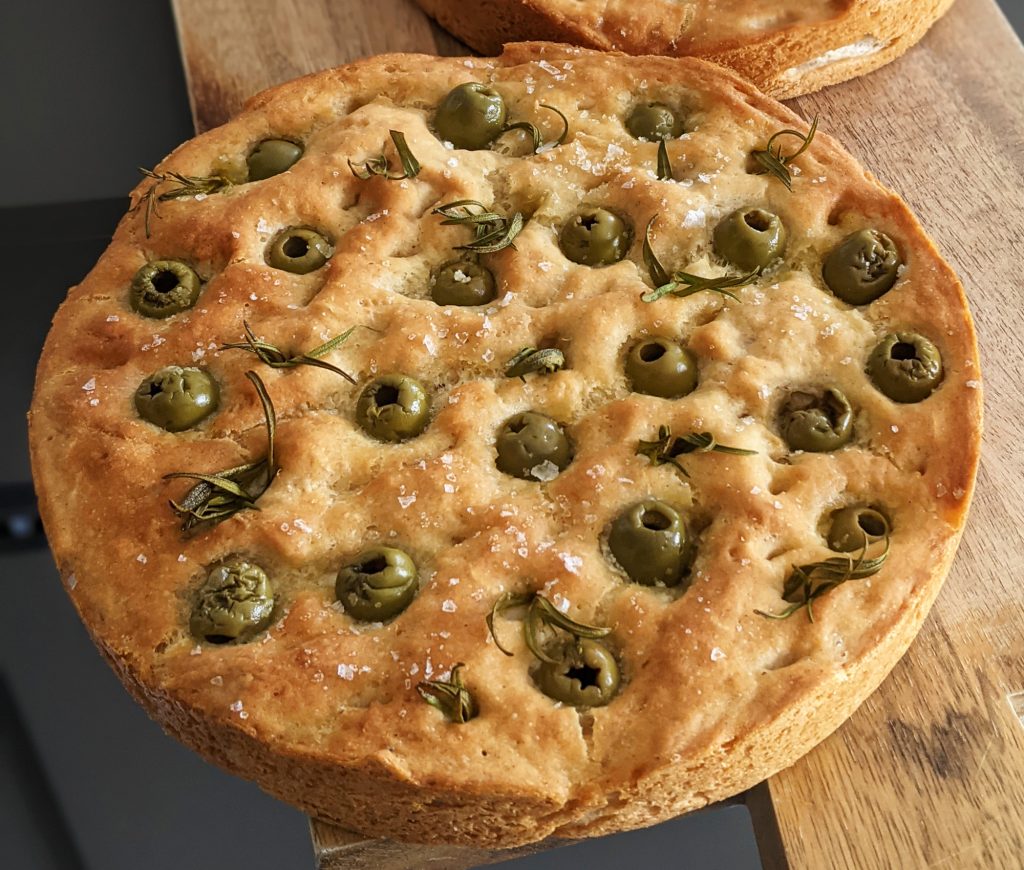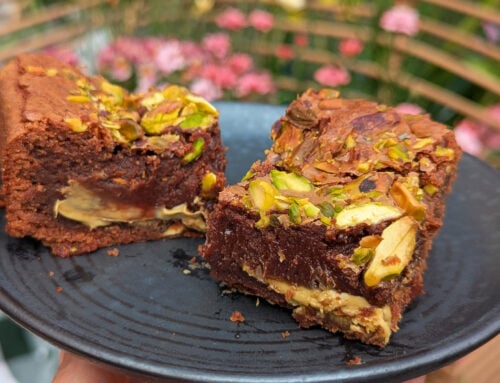Gluten free focaccia is the perfect place to start your gluten free bread baking adventures. It’s an easy bread to make and can be customised with your choice of toppings, once you’ve mastered the basics.
I have recently updated this gluten free focaccia recipe to make is better than ever, super fluffy and delicious, using the Mulino Caputo gluten free flour. We are totally obsessed with this recipe and cannot stop making it – even my non-gluten free friends have been loving eating it!
If you want the original recipe, scroll right to the bottom of this page. Or for another gluten and wheat free alternative, see my cookbook Eat & Enjoy Gluten Free.

Focaccia is an Italian bread with similarities to pizza. It’s traditionally quite flat, although for this one I’ve gone for a bit of height as I really wanted a nice fluffy gluten free focaccia. It contains olive oil so has a lovely soft crumb inside, with golden crispy crusts.
You can enjoy it with all sorts of salads, soups and dinner spreads as a side dish, or even use this lovely tall variety sliced for wonderful sandwiches.

What Toppings Can I Use?
I’ve gone with a classic flakey salt and rosemary topping for my focaccia, although I sometimes add green olives or sundried tomatoes too. You can really add anything you like, just bear in mind that sometimes adding salty ingredients like olives will inhibit the yeast and you won’t get such a big fluffy rise.
Once you’ve got your confidence at making the bread base, have fun experimenting with different toppings. You can even try a “garden focaccia” if you are feeling fancy!

Which Gluten Free Flour Should I Use?
This new gluten free focaccia is made make using the Mulino Caputo Fioreglut Gluten Free flour, which, as regular readers will know, I am a big fan of. I’ve used it to make wood fired pizza, fluffy garlic pizza bread, 3-ingredient wraps, flatbread, white rolls, a bread maker loaf, chocolate babka, cinnamon buns and a gluten free white loaf. It’s magic!
You can buy Mulino Caputo Fioreglut online from various retailers, I’ve linked Fifo (a small specialist Italian online business who sell in the UK), who I’ve found it cheapest with and who I generally buy in bulk from. But you can also get it from Ocado or on Amazon, if you only want to buy a bag or two.
It’s more expensive than the mainstream gluten free flour brands, but is 100% worth it, in my opinion.
Wheat allergy sufferers, please note this flour is not suitable for you, as it contains codex wheat starch. This is suitable for coeliacs (as the gluten has been removed and it’s fully certified) – read this article from Coeliac UK for more information.
Can I Substitute a Different Flour?
No, you must use the caputo flour for this gluten free breadmaker recipe. It will not work with FREEE or other flours. They do not have the right properties.
The only other codex wheat starch-based blend I know of, and which you should have success with, is the Juvela White Mix. Let me know if you give this one a try! I used to be able to get it on prescription (until they scrapped gluten free prescriptions for coeliacs in my area), and it was great.
For those of you in the US, the King Arthur Gluten Free Bread Flour may also be worth a shot, as it contains gluten free wheat starch, however I have not tried it.
My Dough Is Really Sticky – Is That Right?
Yes, the dough for this focaccia is really sticky and not like gluteny bread dough. Gluten free flour needs a higher level of hydration and using a nice wet dough results in a lovely soft crumb. Rather than a hard dry bread.
Wetting your hands allow you to shape this dough easily without it sticking to you. And a dough scraper is a handy piece of equipment for transferring it from the bowl to the baking tin. If you don’t have a dough scraper don’t worry, a tough spatula will do the job nicely.

Is This Gluten Free Focaccia Dairy Free Too?
It sure it! Naturally dairy free, egg free, vegetarian and vegan, this is a great bread to make if you’ve multiple dietary requirements.

Gluten Free Focaccia Recipe
*Please note, this recipe is not suitable for wheat allergy sufferers as the Mulino Caputo Fioreglut flour contains gluten free wheat starch (fine for coeliacs – see Coeliac UK if you’d like to read more).*
This recipe makes enough focaccia to serve 6 people as a side dish. You’ll find the method below with loads of pictures to guide you through it. Feel free to email me any questions or comments you might have. You can contact me at laura@mygfguide.com or message me on Instagram/Facebook @myglutenfreeguide.
If you enjoy this gluten free focaccia, I would be really grateful if you could leave a star rating on the recipe card below. Thank you!
Laura xxx

Gluten Free Focaccia Bread
Ingredients
- 12g dried active yeast (I use Allinson's easy bake yeast)
- 2 tsp caster sugar
- 320ml warm water
- 400g Mulino Caputo Fioreglut Gluten Free Flour (do not substitute with plain gluten free flour)*
- 2 tsp gluten free baking powder
- 1 tsp fine salt
- 40ml olive oil + 20ml for topping the focaccia
- 1 tsp cider vinegar
- To finish: a big pinch Maldon salt, 1 sprig fresh rosemary
Instructions
I recommend making this gluten free focaccia in a spring form baking tin, as it will be much easier to get out. If you need to use a fixed form tin, please line base and sides with non-stick baking paper greased with olive oil. Alternatively, you can also attempt a free-form version on a non-stick baking tray (it won't be as tall and fluffy).
- Combine the warm water, caster sugar and yeast together in a measuring jug, give everything a good stir and then leave to stand for 10-15 minutes (no stirring during this time). The yeast will activate and a thick layer of foam will form on top of the liquid (see image below). If no foam forms, your yeast is dead and you'll need to start again with a fresh packet.
- While the yeast is getting to work you can prepare the tin for the bread. Take a non-stick spring form tin (mine is 23cm wide, slightly smaller/large is fine too, your focaccia will simply be thinner/thicker). Line the bottom of the tin with a circle of non-stick baking paper then liberally grease the entire inside of the tin with olive oil. Set aside.
- Add the Mulino Caputo flour, baking powder and salt to a large mixing bowl or stand mixer bowl. Stir to combine them well.
- Make a well in the centre of the flour in the bowl and add the 40ml olive oil, cider vinegar and contents of the jug. Use a wooden spoon (or dough hook if using a stand mixer) to mix the liquids into the dry ingredients. You'll need some muscle to give it a good stir for a few minutes if making by hand. Mix until you have a really sticky dough, which is still quite wet. If using a stand mixer, mix for 3 minutes on high, scraping down the sides of the bowl halfway through.
- Use a dough scraper or spatula to scrape all the sticky dough into the prepared baking tin. Wet your hands with a little water and then press the dough flat in the tin, ensuring it reaches the edges. With wet fingers make lots of little dimples in the dough (see images below).
- Now cover the tin with a clean, damp cloth or tea towel and set aside in a warm place for around 1 hour. Or until the dough has almost doubled in height and is roughly level with the top of the tin.
- Preheat the oven to 200C (fan). Then once the focaccia has risen, drizzle the remaining 20ml olive oil over the top and gently spread all over with a pastry brush. Sprinkle with a big pinch of Maldon salt and push small springs of rosemary into the dimples you made earlier.
- Place in the middle of the oven and bake for 25 minutes until golden. Remove from the tin and allow to cool before slicing if you can resist...or feel free to tear it into chunks and enjoy while it's still warm :D.
This bread is best enjoyed on the day of baking, but if you have any leftovers pop them in an airtight container and they'll still be nice and soft for a couple more days. Or you can also slice and freeze.
Notes
*This flour blend contains gluten free wheat starch (suitable for coeliacs but not wheat allergy sufferers - see more detail in intro). For an alternative GF WF recipe, see my cookbook Eat & Enjoy Gluten Free.







If you’ve enjoyed my gluten free focaccia, why not try making some of my other gluten free bread recipes:
Enjoy! Laura xxx
p.s. for any long term fans of this recipe, please find the original (using the Schar All Purpose Baking Mix) detailed below.

OLD RECIPE
- 12g dried active yeast (I use Allinson’s easy bake yeast)
- 2 tsp caster sugar
- 260ml warm water
- 325g gluten free flour (I use and would recommend the Schar All Purpose Baking Mix)
- 1 tsp gluten free baking powder (optional, but it gives the bread an extra boost)
- 1.25 tsp xanthan gum
- 1 tsp fine salt
- 40ml olive oil + 20ml for topping the focaccia
- 2 tsp cider vinegar
- To finish: a big pinch Maldon salt, 1 spring fresh rosemary and 50g green olives (optional)
I recommend making this gluten free focaccia in a spring form baking tin, as it will be much easier to get out. If you need to use a fixed form tin, please line with non-stick baking paper greased with olive oil.
- Combine the warm water, caster sugar and yeast together in a measuring jug, give everything a good stir and then leave to stand for 10-15 minutes (no stirring during this time). The yeast will activate and a thick layer of foam will form on top of the liquid (see image below).
- While the yeast is getting to work you can prepare the tin for the bread. Take a non-stick spring form tin (mine is 23cm wide, slightly smaller/large is fine too, your focaccia will simply be thinner/thicker). Line the bottom of the tin with a circle of non-stick baking paper then liberally grease the entire inside of the tin with olive oil. Set aside.
- Add the gluten free flour, baking powder, salt and xanthan gum to a large mixing bowl. Stir to combine them well.
- Make a well in the centre of the flour in the bowl and add the 40ml olive oil, cider vinegar and contents of the jug. Use a wooden spoon to mix the liquids into the dry ingredients. You’ll need some muscle to give it a good stir, I always get a sore arm doing this (but you might be more of a dedicated gym goer than me…kudos if so!). Mix until you have a really sticky dough, which is still quite wet.
- Use a dough scraper or spatula to scrape all the sticky dough into the prepared baking tin. Wet your hands with a little water and then press the dough flat in the tin, ensuring it reaches the edges. With wet fingers make lots of little dimples in the dough.
- Now cover the tin with a clean, damp cloth or tea towel and set aside in a warm place for around 50 minutes. Or until the dough has almost doubled in height.
- Preheat the oven to 180C (fan). Then once the focaccia has risen, drizzle the remaining 20ml olive oil over the top and gently spread all over with a pastry brush. Sprinkle with a big pinch of Maldon salt and push small springs of rosemary and olives into the dimples you made earlier.
- Place in the middle of the oven and bake for 30 minutes until golden. Remove from the tin and allow to cool before slicing if you can resist…or feel free to tear it into chunks and enjoy while it’s still warm :D.
This bread is best enjoyed on the day of baking, but if you have any leftovers pop them in an airtight container and they’ll still be nice and soft for a couple more days.






